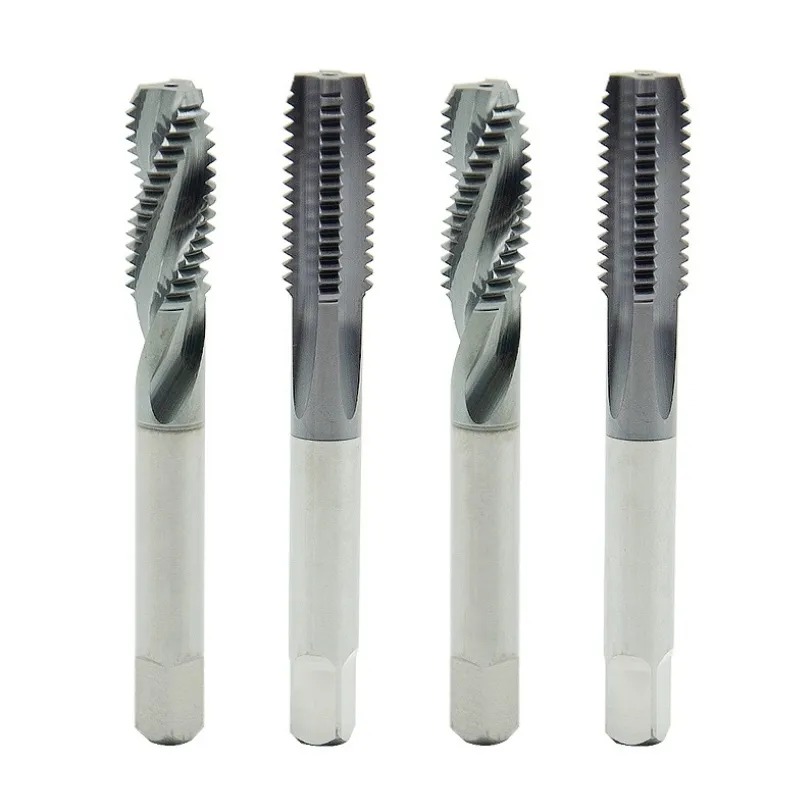In the realm of machining and thread – cutting operations, straight taps hold a significant place. These unassuming yet highly effective tools are used to create internal threads in a wide variety of materials. In this blog post, we’ll take a comprehensive look at straight taps, understanding their design, how they work, their applications, and what makes them a preferred choice in certain scenarios.
Design Features:
Straight taps, as the name implies, have straight flutes running along their length. The simplicity of their design is one of their defining characteristics. These flutes serve multiple purposes. Firstly, they act as channels for chip removal during the threading process. As the tap cuts into the workpiece material, the chips produced are directed through these flutes and out of the hole. The straight – flute design provides a relatively straightforward path for chip evacuation, especially in materials that produce short, easily manageable chips.
The body of a straight tap is typically made from high – quality tool steel. This steel is often heat – treated to enhance its hardness and durability. The cutting edges of the tap are precisely ground to ensure clean and accurate thread formation. Depending on the specific application, straight taps can come in various sizes, with different thread pitches and diameters to accommodate a wide range of hole sizes and threading requirements.
Working Principles:
When a straight tap is used, it is inserted into a pre – drilled hole in the workpiece. The tap is then rotated, usually using a tapping machine or a drill press with tapping capabilities. As the tap rotates, the cutting edges engage with the material of the hole, gradually cutting and forming the internal threads.
The straight flutes play a crucial role in this process. They help in guiding the chips away from the cutting area. In materials where the chips break into small, manageable pieces, the straight flutes can efficiently carry these chips out of the hole. However, in materials that produce long, stringy chips, some additional measures might be required to ensure proper chip evacuation, such as using a chip – breaking compound or periodically reversing the tap’s rotation to break the chips.
Applications:
- General Machining: Straight taps are widely used in general machining applications. They are suitable for creating threads in a variety of materials, including mild steel, brass, and plastics. In small – scale manufacturing workshops, straight taps are often the go – to choice for basic threading needs due to their simplicity and cost – effectiveness. For example, when creating threads in simple mechanical parts like brackets or couplings made of mild steel, straight taps can be used to quickly and accurately form the required internal threads.
- Woodworking: In the woodworking industry, straight taps can be used to create threads in wooden components. This is especially useful when assembling wooden furniture or structures where threaded fasteners are needed. The straight – flute design allows for easy chip removal in wood, which is a soft material that produces relatively large chips. By using a straight tap, woodworkers can create clean and functional threads in wood, enabling the use of screws or bolts for secure connections.
- Repair and Maintenance: Straight taps are also invaluable in repair and maintenance work. When a threaded hole in a machine or a mechanical device becomes damaged or stripped, a straight tap can be used to re – cut the threads and restore the functionality of the hole. This is a common practice in automotive repair shops, where threaded holes in engine blocks, transmissions, or other components might need to be repaired. The straight – flute design makes it easy to access and clean out the damaged threads, allowing for a proper re – threading operation.
Advantages over Other Types of Taps:
- Simplicity and Cost – Effectiveness: One of the major advantages of straight taps is their simplicity of design. This simplicity not only makes them easy to manufacture but also more affordable compared to some of the more complex tap designs, such as spiral point taps or spiral fluted taps. For small – scale operations or applications where cost is a significant factor, straight taps offer a cost – effective solution without sacrificing too much in terms of performance.
- Suitability for Soft Materials: Straight taps are particularly well – suited for use in soft materials like wood and some plastics. The straight flutes can effectively handle the relatively large and soft chips produced by these materials. In contrast, taps with more complex flute designs might not be as effective in these materials as they are optimized for harder materials with different chip – forming characteristics.
- Ease of Use in Tight Spaces: The straight – flute design of these taps makes them easier to use in tight or hard – to – reach spaces. Since there are no complex spiral flutes or other design features that might interfere with access, straight taps can be inserted and rotated in restricted areas more easily. This makes them a preferred choice for certain repair and maintenance tasks where space is limited.
Tips for Using Straight Taps:
- Select the Right Tap: Choosing the appropriate straight tap for the job is crucial. Consider the material of the workpiece, the diameter and depth of the hole, and the required thread pitch. Using the wrong tap can lead to poor thread quality, tap breakage, or difficulty in cutting the threads. For example, if you are working with a hard material like stainless steel, you’ll need a tap made from a high – quality, hardened tool steel and with a design optimized for cutting hard materials.
- Lubrication is Key: Applying a suitable lubricant is essential when using straight taps. A good lubricant reduces friction between the tap and the workpiece, which in turn helps to dissipate heat generated during the cutting process. This not only improves the quality of the thread cut but also extends the lifespan of the tap. For different materials, different types of lubricants are recommended. For example, when tapping metal, a cutting oil is often used, while in woodworking, a wax – based lubricant can be effective.
- Monitor Chip Evacuation: As mentioned earlier, chip evacuation can be a challenge, especially in materials that produce long, stringy chips. Keep an eye on the chip – removal process during tapping. If you notice that chips are starting to clog the flutes, stop the tapping operation and clear the chips. This can be done by carefully removing the tap from the hole and using a brush or compressed air to clean out the flutes. You might also need to adjust your tapping speed or use a chip – breaking technique if the chip – clogging problem persists.
In conclusion, straight taps are a versatile and essential tool in the world of machining and threading. Their simple design, wide range of applications, and cost – effectiveness make them a staple in many workshops, whether for general manufacturing, woodworking, or repair and maintenance tasks. By understanding their design, working principles, and following the proper usage tips, you can make the most of these reliable tools in your projects.

